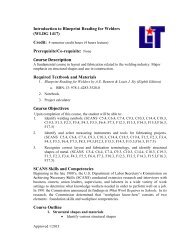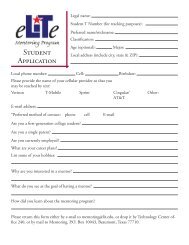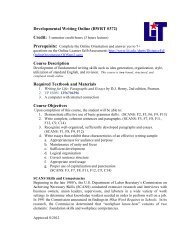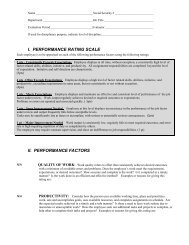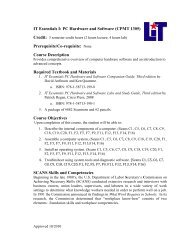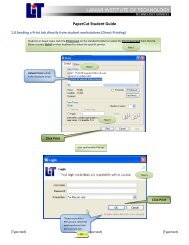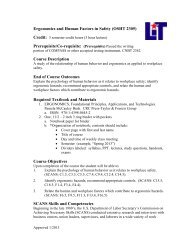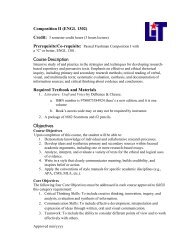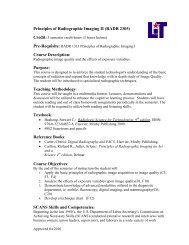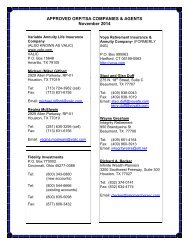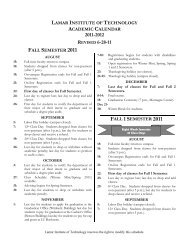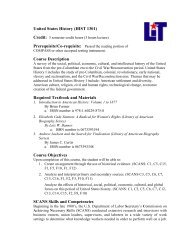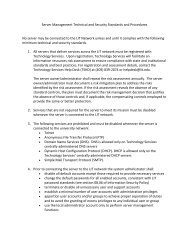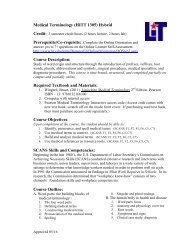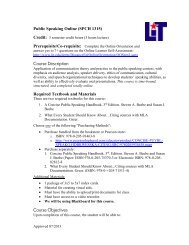LIT Master PLan PDF - Lamar Institute of Technology
LIT Master PLan PDF - Lamar Institute of Technology
LIT Master PLan PDF - Lamar Institute of Technology
Create successful ePaper yourself
Turn your PDF publications into a flip-book with our unique Google optimized e-Paper software.
executive summary<br />
Executive Summary<br />
In August 2008, <strong>Lamar</strong> <strong>Institute</strong> <strong>of</strong> <strong>Technology</strong> (<strong>LIT</strong>)<br />
engaged the architectural, planning, and engineering<br />
firm <strong>of</strong> Freese and Nichols, Inc. to develop a campus<br />
master plan.<br />
The objective <strong>of</strong> the master plan is to provide a 10<br />
year (2020) plan for <strong>Lamar</strong> <strong>Institute</strong> <strong>of</strong> <strong>Technology</strong>,<br />
(<strong>LIT</strong>) to address development and facility needs for the<br />
campus. The master plan will provide a vision for the<br />
development <strong>of</strong> the physical environment to support<br />
and promote the academic values, goals and mission<br />
<strong>of</strong> the <strong>Institute</strong>.<br />
The president <strong>of</strong> <strong>LIT</strong>, Dr. Paul J. Szuch, encouraged community<br />
stakeholders, faculty, staff, and students to participate<br />
in the planning process so that the plan would<br />
be embraced and shaped by everyone’s input. Based<br />
on the planning process and inclusive stakeholder<br />
involvement, this master plan will serve as a comprehensive<br />
guide to assist <strong>LIT</strong> into the future.<br />
Process<br />
The planning team approached the master plan project<br />
through a systematic process comprising Mobilization,<br />
Data Gathering, Analysis/Review, and Recommendations.<br />
In the Mobilization Phase, the planning team<br />
coordinated with <strong>LIT</strong> to prepare schedules and milestones.<br />
<strong>LIT</strong> provided the list <strong>of</strong> the <strong>Master</strong> Planning<br />
Steering Committee members and facilitated meeting<br />
arrangements.<br />
The Data Gathering Phase included a web-based questionnaire<br />
and interview sessions with the community<br />
stakeholders, <strong>Master</strong> Planning Steering Committee,<br />
faculty, staff, and students. The planning team also<br />
collected site data, enrollment trends, and previous<br />
reports and plans.<br />
During the Analysis/Review Phase, the planning team<br />
developed a thorough understanding <strong>of</strong> the opportunities,<br />
constraints, strengths, and weaknesses <strong>of</strong> <strong>LIT</strong>’s<br />
current status. The information gathered from surveys,<br />
interviews, requested information, and campus<br />
site visits served as a foundation for data analysis. The<br />
analyzed data was used to formulate recommendations<br />
for the master plan.<br />
In the Recommendation Phase, the planning team refined<br />
the concept plan to develop the final master plan<br />
recommendations. Narratives, graphics and sketches,<br />
cost estimates, and implementation strategies were<br />
then developed to support the plan. Next, a threephase<br />
implementation approach was developed for<br />
the final document.<br />
<strong>Master</strong> Plan Community Stakeholder Meeting<br />
Recommendations<br />
The final campus master plan is the reflection <strong>of</strong> countless<br />
hours <strong>of</strong> collaboration with the <strong>Institute</strong> and various<br />
stakeholders. A wide range <strong>of</strong> data and comments<br />
were analyzed and discussed during the development<br />
<strong>of</strong> the plan. The final plan reflects several important<br />
campus recommendations to be implemented in a<br />
three-phase approach. While some recommendations<br />
are dependent on the completion <strong>of</strong> others, there is<br />
flexibility in the plan to allow progress to be made in a<br />
future climate <strong>of</strong> change and uncertainty.<br />
Currently, <strong>LIT</strong> is land-locked with few options available<br />
to balance the future need for new facility space,<br />
parking, and exterior green spaces within the existing<br />
footprint. The plan addresses the need for additional<br />
property and illustrates how to fully develop the campus<br />
facilities and grounds in the future.<br />
CAMPUS MASTER PLAN<br />
<strong>Lamar</strong> <strong>Institute</strong> <strong>of</strong> <strong>Technology</strong><br />
4



